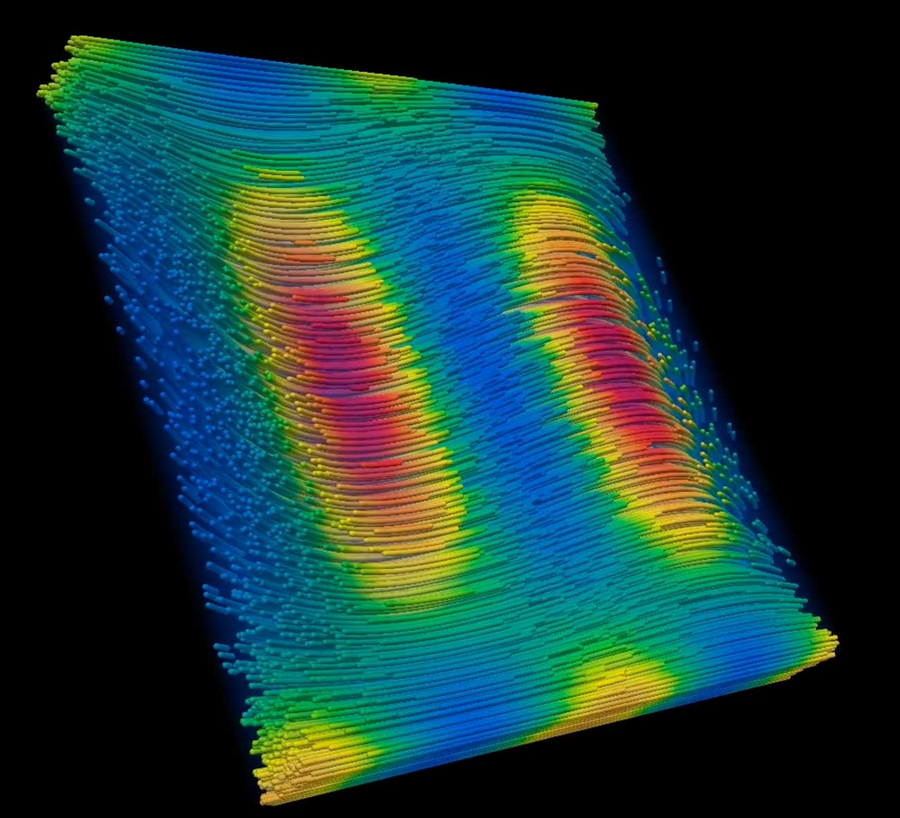
Depiction of the wrinkling instability of active microtubules (colored with distortion in alignment) as predicted by the three-dimensional model. © Singh et al. Physical review Research (2023) / MPI-CBG
Active matter physics is a cornerstone theory to understand biological phenomena across multiple scales, ranging from cellular movement to tissue morphogenesis and the flocking behavior of animals. One such fascinating class of active matter are active fluids. These are densely packed, soft substances whose component parts can flow independently and operate by dissipating energy at the microscopic scale to perform directed motion. Although this offers a general framework that can be applied to practically all of biology, active fluids are incredibly challenging to understand in three dimensions due to increased mathematical and computational complexity. Given the technical obstacles and a lack of the necessary supercomputing scientific software for 3D investigations, only two-dimensional models of active fluids were investigated in the previous decade.
In a current study, the research group of Ivo Sbalzarini, TU Dresden Professor in the Center for Systems Biology Dresden (CSBD), Research Group Leader at the Max Planck Institute of Molecular Cell Biology and Genetics (MPI-CBG), and Dean of the Faculty of Computer Science at the TU Dresden, investigates, together with Frank Jülicher, director at the Max Planck Institute for the Physics of Complex Systems (MPIPKS), how an active fluid behaves in a three-dimensional environment. Recent experiments that directly correspond to the three-dimensional world we live in, have observed that microtubules and kinesin motor protein mixtures can flow on their own in different directions, but a comprehensive theoretical model explaining these observations and how to control them was missing. Abhinav Singh, the first author of the study, explains: “Our most important discovery is that boundary conditions, which are frequently overlooked in ideal physical models, are crucial in the formation of instabilities in active matter. In simple terms, this means that the active material can latch onto and interact with the boundary or surface it is against, and then move in two ways: in the direction of alignment (in-plane) or perpendicular to the alignment of polymers (out-of-plane). Whether it is pulled or pushed by its internal motors, and the way molecules orient at the edges, dictate the movement. Interestingly, we discovered a unique 3D 'rippling' or 'wrinkling' effect that corresponds directly to the observed puzzling behavior of microtubules when they are under a stretching force created by motors called kinesins. These results were confirmed through rigorous mathematical analysis and unprecedented supercomputing codes of novel numerical techniques, marking a significant leap in our understanding of active biological processes.”
“These findings expand our understanding of the behavior of active matter and move us one step closer to unraveling the beautiful complexity of morphogenesis,” concludes Ivo Sbalzarini, who supervised the study. “Our findings and software contributions in OpenFPM will be instrumental for physicists, biologists, and materials scientists who are looking into the behavior of active fluids made up of living materials. This new understanding can enhance the manipulation and control of active fluids, paving the way for a range of applications, from microfluidic devices to drug delivery systems and novel material designs. However, further research is necessary to validate our findings in various real-world scenarios.”
Abhinav Singh, Quentin Vagne, Frank Jülicher, and Ivo F. Sbalzarini: Spontaneous flow instabilities of active polar fluids in three dimensions. Phys. Rev. Research 5, L022061 – Published 22 June 2023, DOI: https://doi.org/10.1103/PhysRevResearch.5.L022061